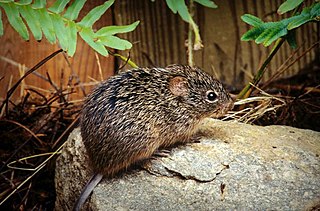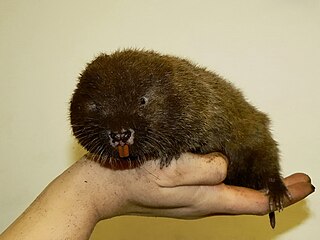
The muskrat is a medium-sized semiaquatic rodent native to North America and an introduced species in parts of Europe, Asia, and South America. The muskrat is found in wetlands over a wide range of climates and habitats. It has important effects on the ecology of wetlands, and is a resource of food and fur for humans.

The rodent subfamily Sigmodontinae includes New World rats and mice, with at least 376 species. Many authorities include the Neotominae and Tylomyinae as part of a larger definition of Sigmodontinae. When those genera are included, the species count numbers at least 508. Their distribution includes much of the New World, but the genera are predominantly South American, such as brucies. They invaded South America from Central America as part of the Great American Interchange near the end of the Miocene, about 5 million years ago. Sigmodontines proceeded to diversify explosively in the formerly isolated continent. They inhabit many of the same ecological niches that the Murinae occupy in the Old World.

The desert woodrat is a species of pack rat native to desert regions of western North America.

The blesmols, also known as mole-rats, or African mole-rats, are burrowing rodents of the family Bathyergidae. They represent a distinct evolution of a subterranean life among rodents much like the pocket gophers of North America, the tuco-tucos in South America, or the Spalacidae from Eurasia.

Oryzomys is a genus of semiaquatic rodents in the tribe Oryzomyini living in southern North America and far northern South America. It includes eight species, two of which—the marsh rice rat (O. palustris) of the United States and O. couesi of Mexico and Central America—are widespread; the six others have more restricted distributions. The species have had eventful taxonomic histories, and most species were at one time included in the marsh rice rat; additional species may be recognized in the future. The name Oryzomys was established in 1857 by Spencer Fullerton Baird for the marsh rice rat and was soon applied to over a hundred species of American rodents. Subsequently, the genus gradually became more narrowly defined until its current contents were established in 2006, when ten new genera were established for species previously placed in Oryzomys.

The Siberian weasel or kolonok, is a medium-sized weasel native to Asia, where it is widely distributed and inhabits various forest habitats and open areas. It is therefore listed as Least Concern on the IUCN Red List.

The dwarf little fruit bat is a species of leaf-nosed bat from South America.

The common punaré, is a species of spiny rat endemic to Brazil.

Lundomys molitor, also known as Lund's amphibious rat or the greater marsh rat, is a semiaquatic rat species from southeastern South America.

Sumichrast's vesper rat is a rodent of the family Cricetidae found from southern Mexico to Panama. It is named for François Sumichrast, the collector of the first specimen, and its closest relative is probably Hatt's vesper rat, a similar, but slightly smaller, species from the Yucatán Peninsula.

The red rock rat, or red veld rat, is a species of rodent in the family Muridae native to southern Africa.
Holochilus chacarius, also known as the Chacoan marsh rat or Chaco marsh rat, is a semiaquatic rodent species in the family Cricetidae. It is found in Argentina and Paraguay within the Gran Chaco.

Holochilus is a genus of semiaquatic rodents in the tribe Oryzomyini of family Cricetidae, sometimes called marsh rats. It contains five living species, H. brasiliensis, H. chacarius, H. nanus, H. oxe, and H. sciureus, which are widely distributed in South America east of the Andes. A fourth species from the Pleistocene of Bolivia was formerly classified as H. primigenus, but is now placed in the genus Reigomys.

The marsh rice rat is a semiaquatic North American rodent in the family Cricetidae. It usually occurs in wetland habitats, such as swamps and salt marshes. It is found mostly in the eastern and southern United States, from New Jersey and Kansas south to Florida and northeasternmost Tamaulipas, Mexico; its range previously extended further west and north, where it may have been a commensal in corn-cultivating communities. Weighing about 40 to 80 g, the marsh rice rat is a medium-sized rodent that resembles the common black and brown rat. The upperparts are generally gray-brown, but are reddish in many Florida populations. The feet show several specializations for life in the water. The skull is large and flattened, and is short at the front.

The bunny rat, or hairy-soled conyrat is a species of rodent in the family Cricetidae, native to southern South America.

The lesser bamboo rat is a species of rodent in the family Spalacidae. It is monotypic within the genus Cannomys. It is found in Bangladesh, Bhutan, Cambodia, China, India, Myanmar, Nepal, and Thailand.

A pack rat or packrat, also called a woodrat or trade rat, are any species in the North and Central American rodent genus Neotoma. Pack rats have a rat-like appearance, with long tails, large ears, and large, black eyes. Pack rats are noticeably larger than deer mice, harvest mice, and grasshopper mice, and are usually somewhat larger than cotton rats.

The Amazonian grosbeak or Rothschild's grosbeak is a species of grosbeak in the family Cardinalidae, the cardinals or cardinal grosbeaks. It is found in much of the Amazon Basin, in Bolivia, Brazil, Colombia, French Guiana, Guyana, Peru, Suriname, and Venezuela.

The Guianan squirrel monkey is a species of squirrel monkey from Guiana, Venezuela and Brazil. S. sciureus formerly applied to Humboldt's squirrel monkey and Collins' squirrel monkey, but genetic research in 2009 and 2015 revealed that these are distinct species.

The Ecuadorian squirrel monkey is a type of squirrel monkey. It had been considered a subspecies of the Guianan squirrel monkey, Saimiri sciureus, but was elevated to a full species, S. macrodon, based on a 2009 study by Carretero-Pinzón, et al. Based on subsequent genetic research by Jessica Lynch Alfaro, et al it was again reclassified as a subspecies of Humboldt's squirrel monkey.


















